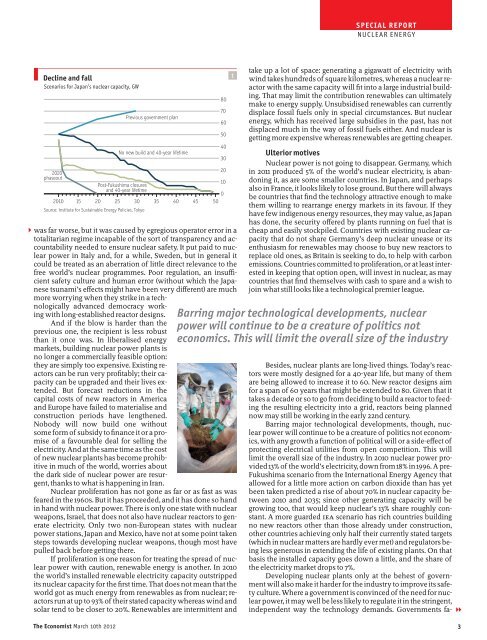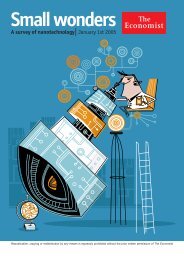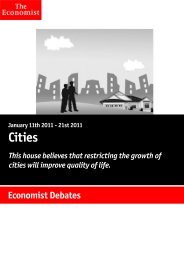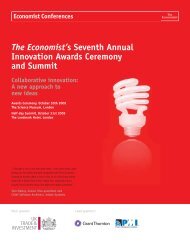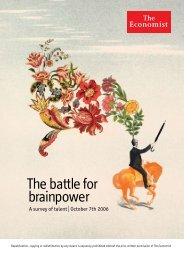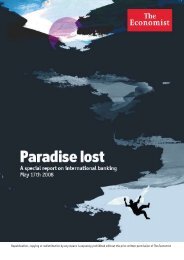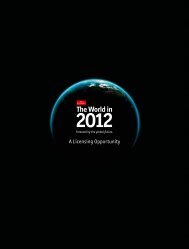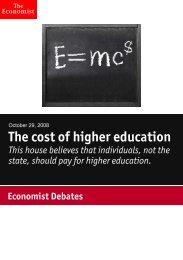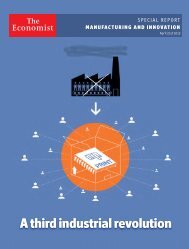The dream that failed
The dream that failed
The dream that failed
You also want an ePaper? Increase the reach of your titles
YUMPU automatically turns print PDFs into web optimized ePapers that Google loves.
2<br />
Decline and fall<br />
Scenarios for Japan’s nuclear capacity, GW<br />
Source: Institute for Sustainable Energy Policies, Tokyo<br />
Previous government plan<br />
No new build and 40-year lifetime<br />
2020<br />
phaseout<br />
Post-Fukushima closures<br />
and 40-year lifetime<br />
20<br />
10<br />
0<br />
2010 15 20 25 30 35 40 45 50<br />
was far worse, but it was caused by egregious operator error in a<br />
totalitarian regime incapable of the sort of transparency and accountability<br />
needed to ensure nuclear safety. It put paid to nuclear<br />
power in Italy and, for a while, Sweden, but in general it<br />
could be treated as an aberration of little direct relevance to the<br />
free world’s nuclear programmes. Poor regulation, an insucient<br />
safety culture and human error (without which the Japanese<br />
tsunami’s eects might have been very dierent) are much<br />
more worrying when they strike in a tech-<br />
nologically advanced democracy working<br />
with long-established reactor designs.<br />
And if the blow is harder than the<br />
previous one, the recipient is less robust<br />
than it once was. In liberalised energy<br />
markets, building nuclear power plants is<br />
no longer a commercially feasible option:<br />
they are simply too expensive. Existing reactors<br />
can be run very protably; their capacity<br />
can be upgraded and their lives extended.<br />
But forecast reductions in the<br />
capital costs of new reactors in America<br />
and Europe have <strong>failed</strong> to materialise and<br />
construction periods have lengthened.<br />
Nobody will now build one without<br />
some form of subsidy to nance it or a promise<br />
of a favourable deal for selling the<br />
electricity. And at the same time as the cost<br />
of new nuclear plants has become prohibitive<br />
in much of the world, worries about<br />
the dark side of nuclear power are resurgent,<br />
thanks to what is happening in Iran.<br />
Nuclear proliferation has not gone as far or as fast as was<br />
feared in the 1960s. But it has proceeded, and it has done so hand<br />
in hand with nuclear power. <strong>The</strong>re is only one state with nuclear<br />
weapons, Israel, <strong>that</strong> does not also have nuclear reactors to generate<br />
electricity. Only two non-European states with nuclear<br />
power stations, Japan and Mexico, have not at some point taken<br />
steps towards developing nuclear weapons, though most have<br />
pulled back before getting there.<br />
If proliferation is one reason for treating the spread of nuclear<br />
power with caution, renewable energy is another. In 2010<br />
the world’s installed renewable electricity capacity outstripped<br />
its nuclear capacity for the rst time. That does not mean <strong>that</strong> the<br />
world got as much energy from renewables as from nuclear; reactors<br />
run at up to 93% of their stated capacity whereas wind and<br />
solar tend to be closer to 20%. Renewables are intermittent and<br />
80<br />
70<br />
60<br />
50<br />
40<br />
30<br />
1<br />
SPECIAL REPORT<br />
NUCLEAR ENERGY<br />
take up a lot of space: generating a gigawatt of electricity with<br />
wind takes hundreds of square kilometres, whereas a nuclear reactor<br />
with the same capacity will t into a large industrial building.<br />
That may limit the contribution renewables can ultimately<br />
make to energy supply. Unsubsidised renewables can currently<br />
displace fossil fuels only in special circumstances. But nuclear<br />
energy, which has received large subsidies in the past, has not<br />
displaced much in the way of fossil fuels either. And nuclear is<br />
getting more expensive whereas renewables are getting cheaper.<br />
Ulterior motives<br />
Nuclear power is not going to disappear. Germany, which<br />
in 2011 produced 5% of the world’s nuclear electricity, is abandoning<br />
it, as are some smaller countries. In Japan, and perhaps<br />
also in France, it looks likely to lose ground. But there will always<br />
be countries <strong>that</strong> nd the technology attractive enough to make<br />
them willing to rearrange energy markets in its favour. If they<br />
have few indigenous energy resources, they may value, as Japan<br />
has done, the security oered by plants running on fuel <strong>that</strong> is<br />
cheap and easily stockpiled. Countries with existing nuclear capacity<br />
<strong>that</strong> do not share Germany’s deep nuclear unease or its<br />
enthusiasm for renewables may choose to buy new reactors to<br />
replace old ones, as Britain is seeking to do, to help with carbon<br />
emissions. Countries committed to proliferation, or at least interested<br />
in keeping <strong>that</strong> option open, will invest in nuclear, as may<br />
countries <strong>that</strong> nd themselves with cash to spare and a wish to<br />
join what still looks like a technological premier league.<br />
Barring major technological developments, nuclear<br />
power will continue to be a creature of politics not<br />
economics. This will limit the overall size of the industry<br />
Besides, nuclear plants are long-lived things. Today’s reactors<br />
were mostly designed for a 40-year life, but many of them<br />
are being allowed to increase it to 60. New reactor designs aim<br />
for a span of 60 years <strong>that</strong> might be extended to 80. Given <strong>that</strong> it<br />
takes a decade or so to go from deciding to build a reactor to feeding<br />
the resulting electricity into a grid, reactors being planned<br />
now may still be working in the early 22nd century.<br />
Barring major technological developments, though, nuclear<br />
power will continue to be a creature of politics not economics,<br />
with any growth a function of political will or a side-eect of<br />
protecting electrical utilities from open competition. This will<br />
limit the overall size of the industry. In 2010 nuclear power provided<br />
13% of the world’s electricity, down from 18% in 1996. A pre-<br />
Fukushima scenario from the International Energy Agency <strong>that</strong><br />
allowed for a little more action on carbon dioxide than has yet<br />
been taken predicted a rise of about 70% in nuclear capacity between<br />
2010 and 2035; since other generating capacity will be<br />
growing too, <strong>that</strong> would keep nuclear’s 13% share roughly constant.<br />
A more guarded IEA scenario has rich countries building<br />
no new reactors other than those already under construction,<br />
other countries achieving only half their currently stated targets<br />
(which in nuclear matters are hardly ever met) and regulators being<br />
less generous in extending the life of existing plants. On <strong>that</strong><br />
basis the installed capacity goes down a little, and the share of<br />
the electricity market drops to 7%.<br />
Developing nuclear plants only at the behest of government<br />
will also make it harder for the industry to improve its safety<br />
culture. Where a government is convinced of the need for nuclear<br />
power, it may well be less likely to regulate it in the stringent,<br />
independent way the technology demands. Governments fa-<br />
<strong>The</strong> Economist March 10th 2012 3<br />
1


